Are you planning a Las Vegas to Death Valley day trip? Perfect! We have created two efficient and action packed one day in Death Valley National Park itinerary options for you to use. Both Death Valley day trip itinerary options start and end in Las Vegas, and they hit all of the best things to do in the park.
Is one day is enough time to see the top Death Valley highlights?
Yes, you can see most of the popular Death Valley attractions on a day trip from Las Vegas.
It will be a long day and there are several ways you can do it depending on your travel goals, but either way you will still leave having ticket off the top bucket list spots.
Here’s what we will show you:
- Weather and safety in Death Valley
- Driving distances from Las Vegas to Death Valley
- The best things to do in Death Valley
- 2 ways you can drive a Las Vegas to Death Valley day trip
Let’s get stuck into your unforgettable one day in Death Valley National Park from Las Vegas itinerary!
Is Death Valley Worth The Day Trip From Las Vegas?
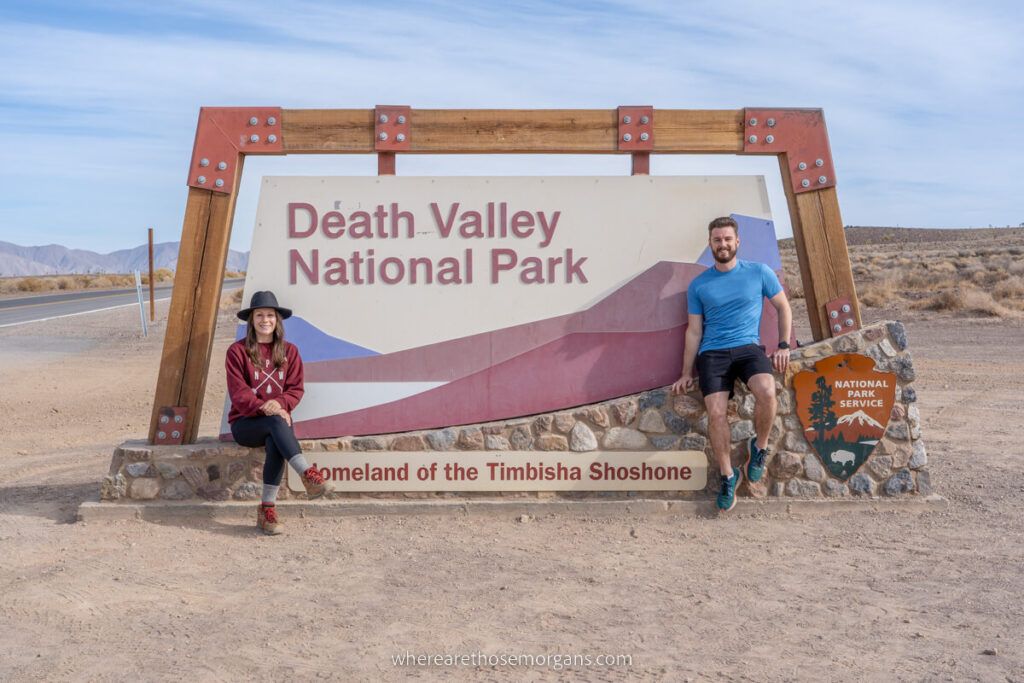
Let’s start with the most obvious question, is Death Valley actually worth a day on your Las Vegas itinerary?
The problem you have is that there are several amazing day trip options from Las Vegas, each offering a completely different experience.
However, we personally think Death Valley is one of the best national parks in the USA and strongly recommend you go ahead with plans to visit the hostile desert for a day.
It’s not every day you get to stand at the lowest point in North America, see endless miles of harsh terrain and hike through unique maze-like canyons.
And the best part is that Death Valley is far more beautiful than you may have been led to believe.
Weather In Death Valley National Park
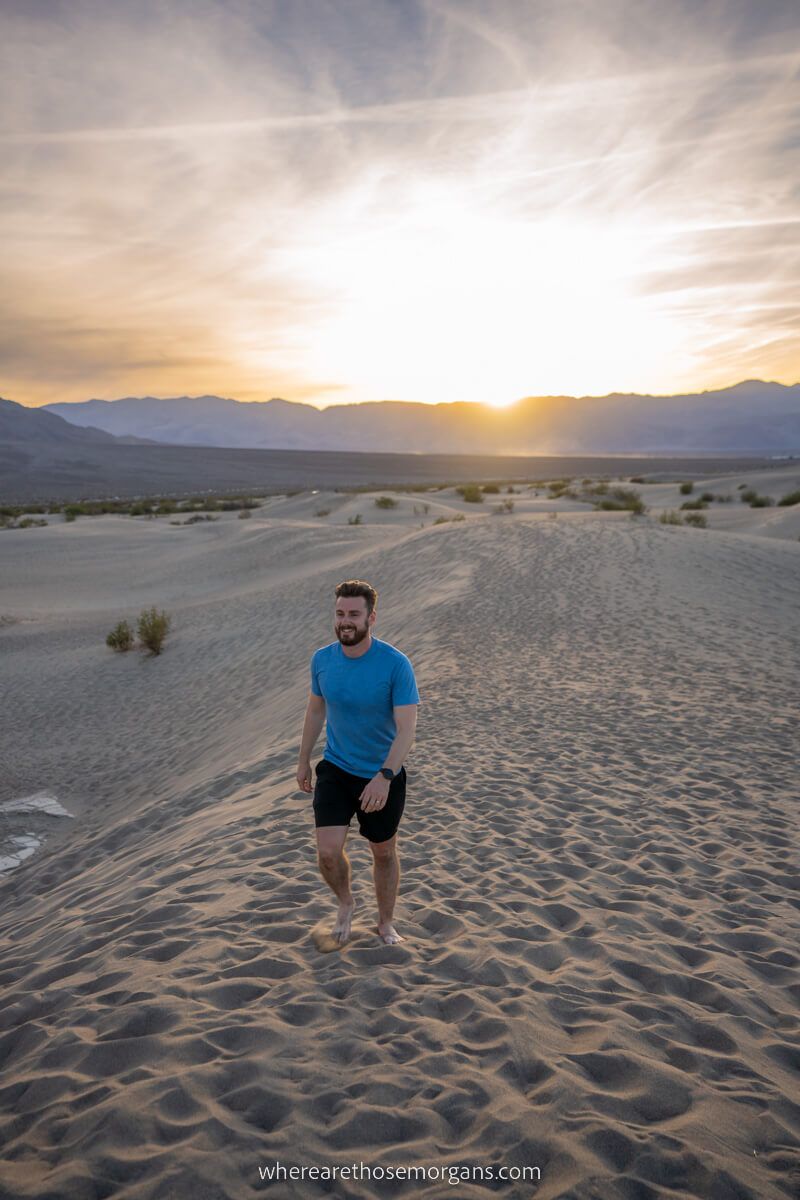
It’s important to address potential weather concerns before you day trip from Las Vegas to Death Valley.
Peak visiting season at Death Valley falls between October and April instead of the typical Summer high season. There’s a reason for that!
- Hottest Recorded Day – July 10, 1913 the world’s hottest air temperature record was set and has not been broken: 134 F (56.6 C).
- Consecutive Days Over 120 F – 43 in a row over 120 degrees in 1917.
- Yearly Averages – Over a 10 year period from 2010-2019, average highs in June 113 F (45 C), July 118 F (48 C) and August 116 F (47 C).
You get the picture.
Death Valley is the hottest, driest and lowest US National Park. It should not be visited in Summer, unless you enjoy being turned into flames.
Why Is Death Valley So Hot?
Flanking the narrow low lying Death Valley basin are two tall and steep mountain ranges.
When heat is absorbed by the dry, arid desert surface, it radiates upwards and the mountains trap this hot air before recycling it back to the valley floor.
Death Valley is like one gigantic heat trap.
What Else Do You Need To Know?
Summer monsoons in Death Valley can lead to flash floods, particularly later in the Summer close to Fall.
Fall, Winter and Spring have more pleasant temperatures in Death Valley, but you still need to be aware of high winds leading to sudden dust storms.
We camped at Texas Springs campground in Furnace Creek (right in the middle of Death Valley) a few years ago and our tent was blown down at 4am by a dust storm.
Hopefully you’ll have a nice clear and cool day when you visit Death Valley, but it is important to be aware of weather conditions before you leave Las Vegas.
Planning a winter visit to Death Valley?
Read our guide to the 10 key things you need to know about visiting Death Valley in December so you know exactly what to expect.
Safety In Death Valley
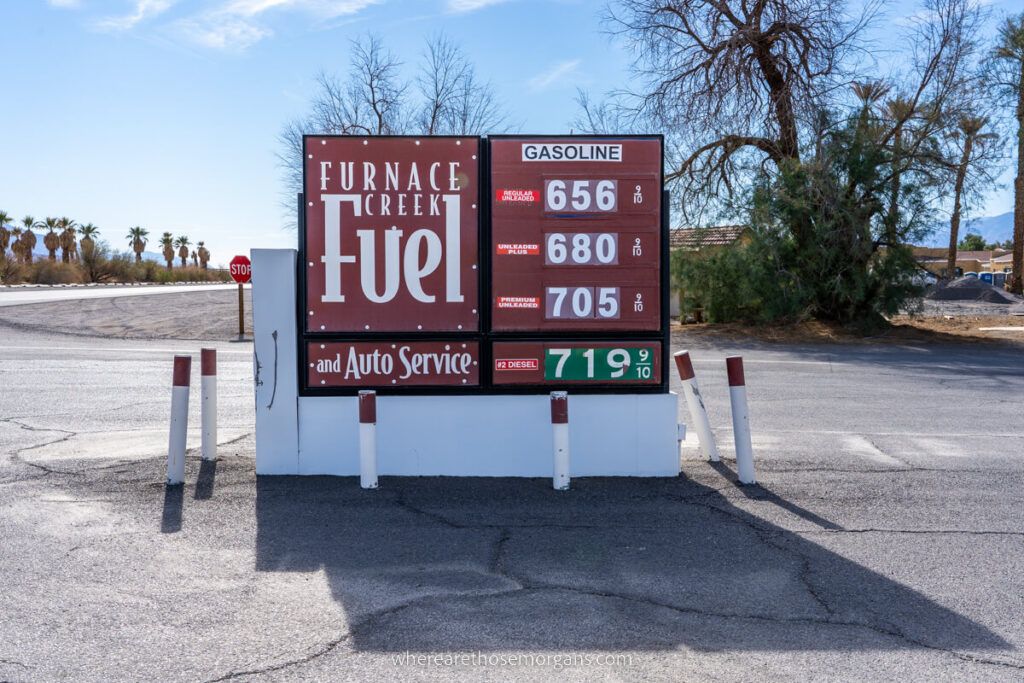
Before you drive from Las Vegas to Death Valley National Park you should perform a series of safety checks.
Death Valley is no joke, especially on hotter days between May and September. Even in Winter months you can easily run into problems.
It isn’t just heat, there’s also a lot of dust and sand in the desert. All of these things can cause havoc with your car, breathing and general wellbeing.
Las Vegas To Death Valley Day Trip Safety Checks
- Fully stocked supply of drinking water and enough food to last a full day
- If you plan to hike in Death Valley, you need to carry even more water
- Spare car parts and at least one spare tire
- All car fluids should be filled before you arrive, including oil and coolant
- Full gas tank (you do not want to run out of gas in the middle of nowhere here)
- Fill up in Las Vegas, Pahrump or Beatty before you enter the park to save on gas prices
- Sunscreen goes without saying but hats and even thin layers for sun protection are a good idea
If you do decide to visit Death Valley in Summer, use extreme caution when hiking any trails at or below sea level.
Las Vegas To Death Valley Day Trip Driving Distances
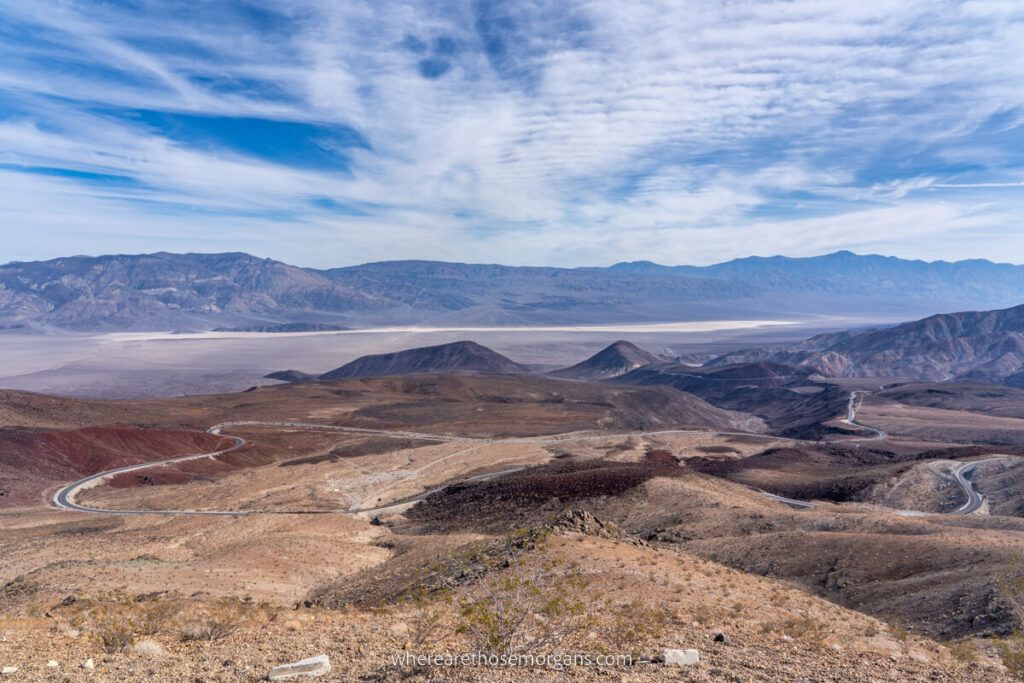
Death Valley is the largest US national park in the contiguous 48 states. It is enormous!
However, most of the top attractions and hikes are down in the southeast portion of Death Valley, nearest to Las Vegas.
There are two major ways in and out of Death Valley if you are driving a day trip from Las Vegas.
- Entering via Death Valley Junction
- Entering via Beatty
The 2 Las Vegas to Death Valley day trip itinerary options we will cover in this guide loop in opposite directions via both entrances.
Las Vegas To Death Valley Junction
The most common way to enter and exit Death Valley National Park is via southeast entrance and Death Valley Junction.
- Distance from Las Vegas to Death Valley Junction: 93 miles
- Drive time from Las Vegas to Death Valley Junction: 1 hour 35 minutes
Las Vegas To Beatty
Beatty is where you will find the east entrance to Death Valley National Park. It is close to a few attractions and makes for the perfect loop road trip route with Death Valley Junction.
- Distance from Las Vegas to Beatty: 117 miles
- Drive time from Las Vegas to Death Valley Junction: 1 hour 45 minutes
Death Valley Junction To Beatty
The only thing left to show you now is the drive distance and time between the two park entrances. Our itineraries will drive in opposite directions between Death Valley Junction and Beatty.
- Distance from Death Valley Junction to Beatty: 70 miles
- Drive time from Death Valley Junction to Beatty: 1 hour 15 minutes
What You Need To Know Before Your One Day Death Valley Itinerary
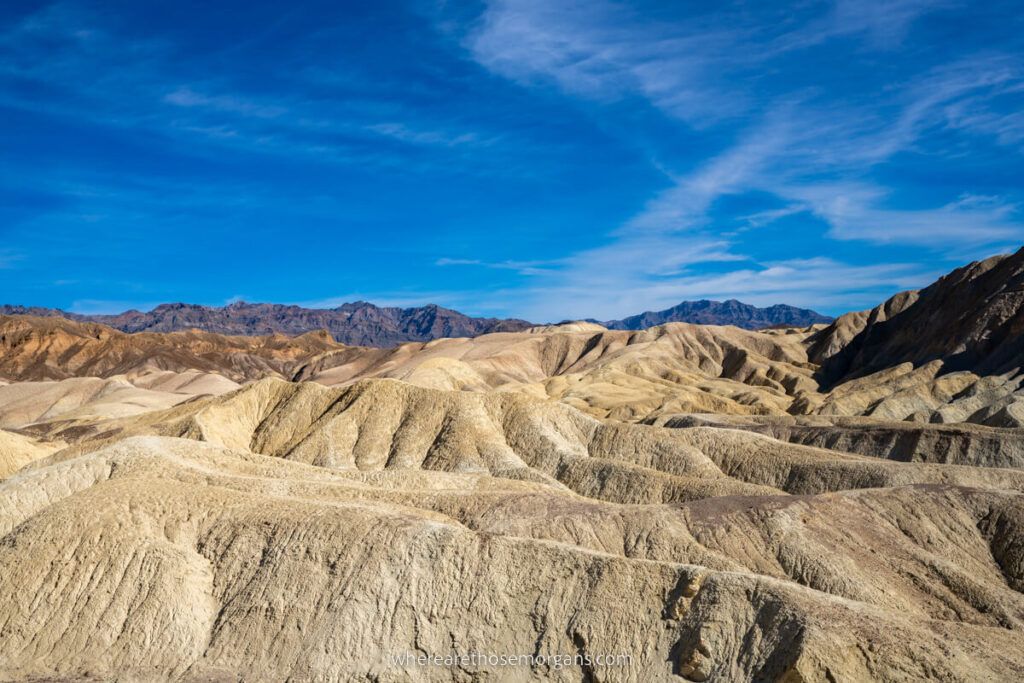
Death Valley is gigantic, so you won’t be able to do every single one of the best things in just one day. However, we will get you through the majority of highlights in this awesome National Park.
How your one day in Death Valley goes will depend on how much you want to hike, whether you have a 4WD vehicle and what the weather is like.
For instance, if you have a Jeep or other 4WD car, you should not miss Titus Canyon. But it is not recommended for low clearance vehicles and we understand not everyone visiting Death Valley will have a high clearance car.
Similarly, if you’re a big hiker, you will naturally spend more time on trails and that means you may have to cut one or two other Death Valley attractions.
Use our itineraries as a guide, but fine tune it to suit your goals.
Visiting the big cities in California?
Don’t miss our popular guides to San Diego, Los Angeles and San Francisco, including the best things to do and example itineraries.
Death Valley National Park Factfile
Address: PO Box 579, Death Valley, CA 92328
Website: nps.gov/deva
Phone: (760) 786-3200
Park Hours: All day, every day
Entrance Fee: US$ 30 Vehicle 7 Day Pass (free with America the Beautiful Pass)
Visitor Center: Furnace Creek, open 8am – 5pm all year
Campgrounds: 4 Large and 5 Small (see campgrounds)
Accommodation: Small number in and around the National Park (see hotels & lodging)
Backcountry camping: Yes, no permit required
Annual Visitors: 1.5 million
Best Time to Visit: October – April to avoid extreme temperatures in Summer
Best Things To Do On A Day Trip From Las Vegas To Death Valley
Let’s get into a quick list of the top Death Valley attractions.
Afterwards, we will organize the highlights into 2 itineraries you can use a guide to plan your day trip.
1. Zabriskie Point
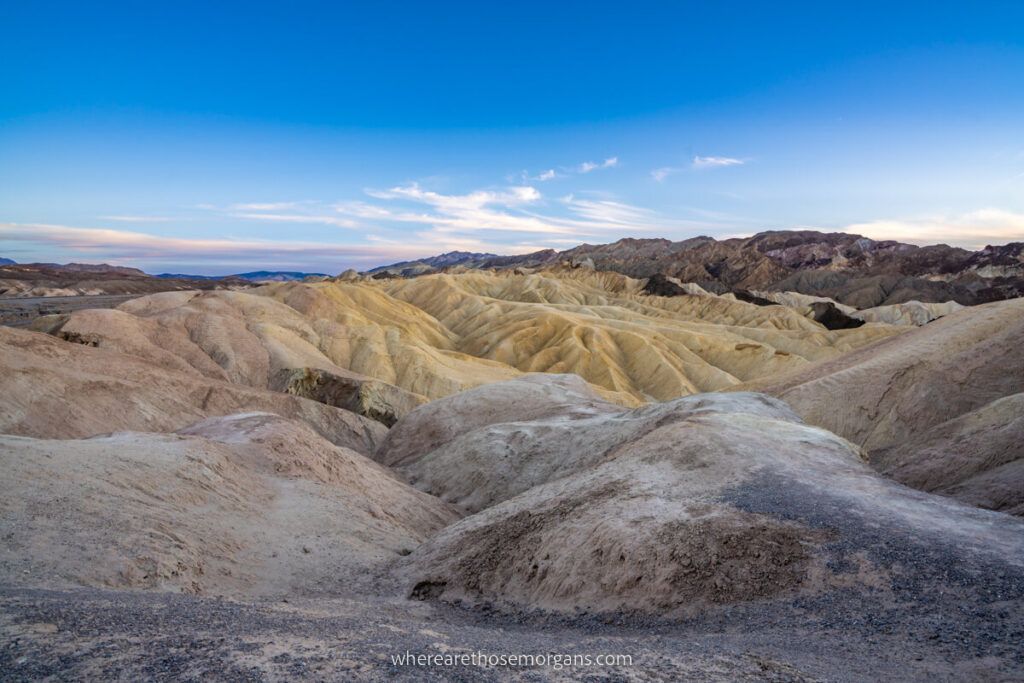
Zabriskie Point is the most popular spot in Death Valley National Park to watch a stunning sunrise or sunset. It has a high vantage point overlooking Death Valley’s Badlands, Red Cathedral and towering Panamint Mountains.
The distant mountains glow a fiery red under the first rays of sunlight or you can watch the sun setting behind those very mountains in the evening. Our itinerary options below start or end at Zabriskie Point.
From the Zabriskie Point parking lot you will follow a short but fairly steep S-shaped path until it reaches the overlook.
Most people use Zabriskie Point as a photography spot but you can begin / end a moderately difficult 2.5 mile hike through Death Valley’s Badlands from here.
However, we recommend starting this hike from a different trailhead, which we will cover later.
Time Required: 1 hour to enjoy a gorgeous sunrise or sunset
2. Badwater Basin
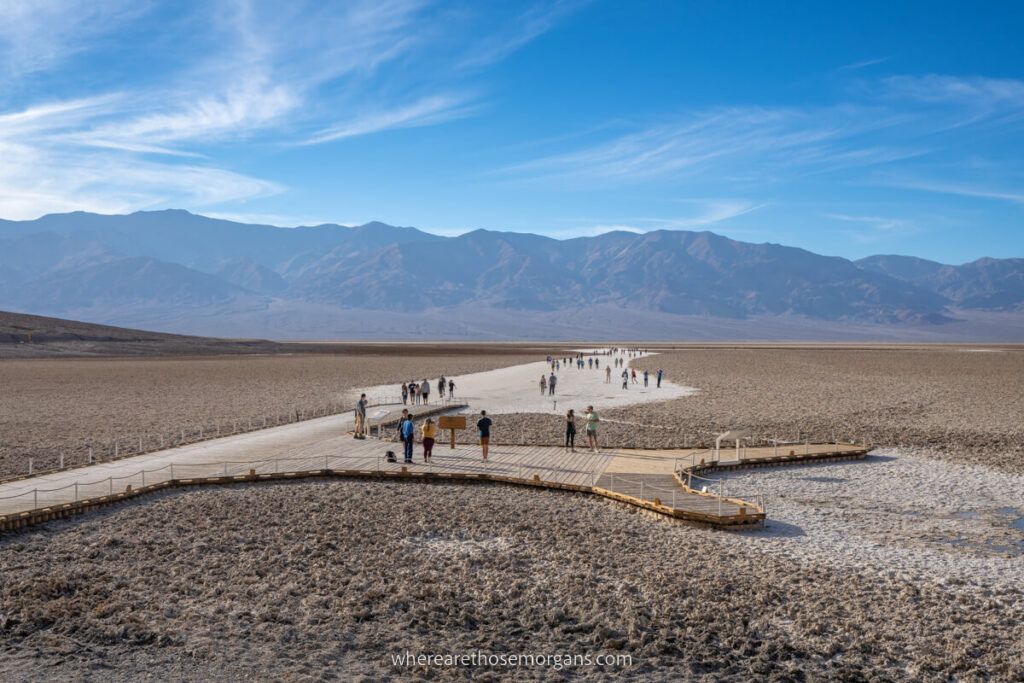
Sitting at 282 feet (86m) below sea level, the salt flats of Badwater Basin form North America’s lowest point.
Badwater Basin’s salt flat area is enormous and you can walk out among it for as long as you like. Just remember you have to come back on yourself!
If you time it right between freeze-thaw and evaporation cycles, you will see quintessential salt hexagons associated with this type of climate.
Occasionally, the salt flats fill with a shallow temporary lake after heavy rainfall.
However, except for a small spring fed water feature located right next to the parking lot, Death Valley’s extremely dry climate quickly evaporates any attempts by the lake to make itself a permanent fixture.
This is the most popular and touristy area of Death Valley, so expect the parking lot to fill unless you arrive early or late in the day.
If you’re a photographer, Badwater Basin is best visited at sunrise, sunset or when there are interesting cloud formations. Panamint Mountains to one side and Black Mountains to the other make a fantastic frame.
Don’t forget to grab a photograph of the iconic wooden sign, the lowest point in North America.
Time Required: 1 hour to walk out and back.
3. Natural Bridge
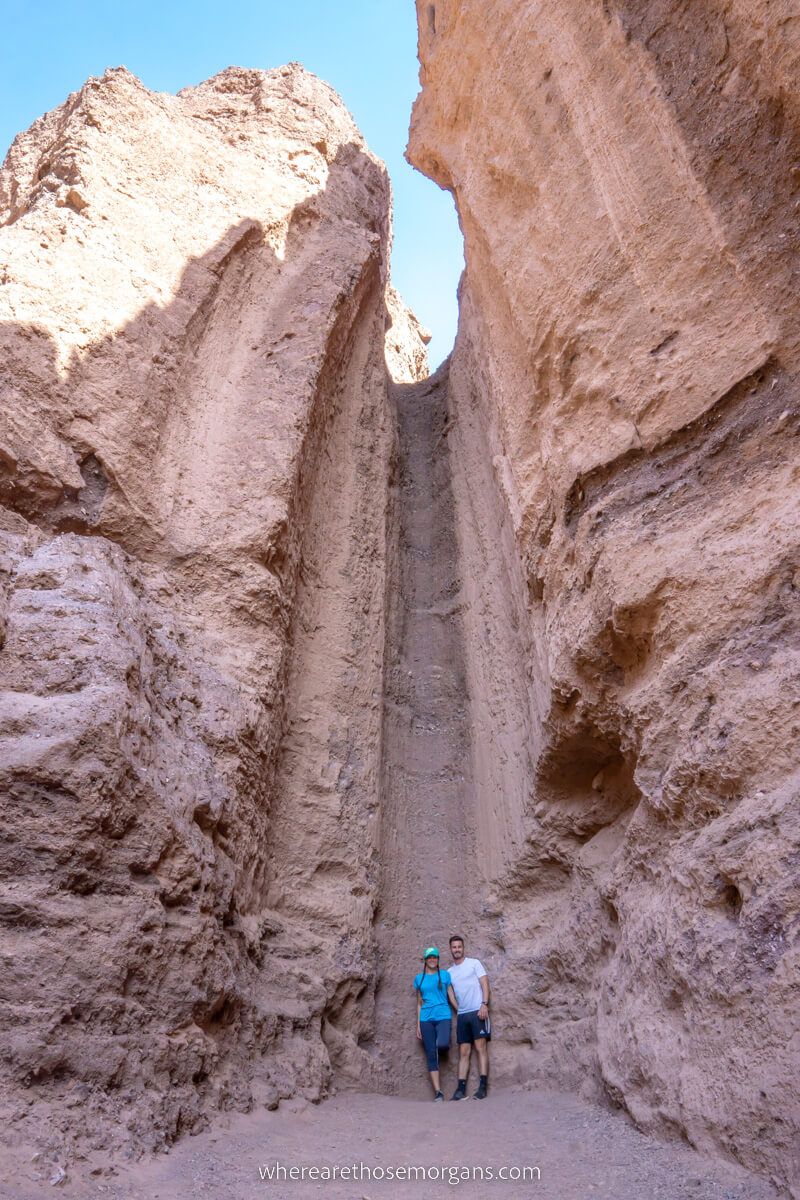
If you’re interested in understanding Death Valley’s geological history, don’t miss this short hike up a narrow canyon with a 50 feet tall natural orange sandstone bridge.
This 2 mile round-trip hike should take around 1 hour to complete but allow a little more time for exploring.
There is more to see on the Natural Bridge hike, including one tall and narrow dried up waterfall with a smooth semi-cylindrical shoot, plus one wider shorter dried up waterfall with sharp boulders marking the end of the trail.
Be aware the hike up to Natural Bridge is slightly uphill.
Gravel and larger stones underfoot make the going fairly tiring. But that means your return slightly downhill is a piece of cake.
Time Required: 1 hour out and back.
4. Artist’s Palette Drive
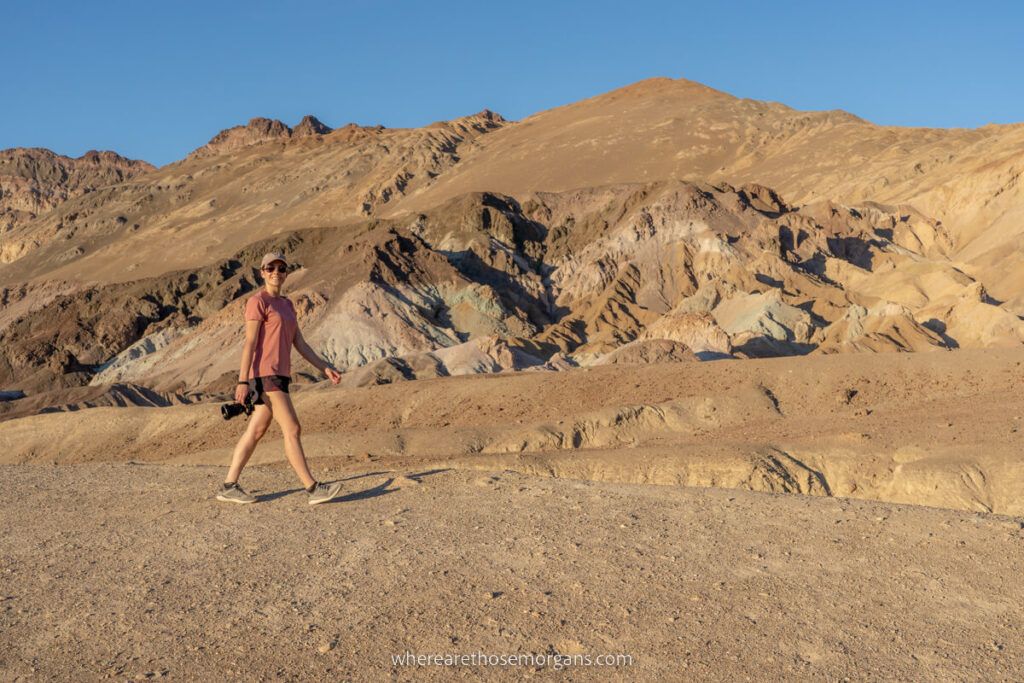
Drive the fun one-way horseshoe shaped scenic road through artists palette to see vibrant turquoise, brown and red rocks.
Many people drive this loop twice or even three times in a row. The brightly colored rocks look out of place in a desolate environment which adds to their appeal.
This is perfect for the less able because you can see the best bits from your vehicle. That being said, getting out to walk among the kaleidoscope of colors is much more interesting!
Time Required: 1 hour total for drive and walk.
5. Golden Canyon Hike
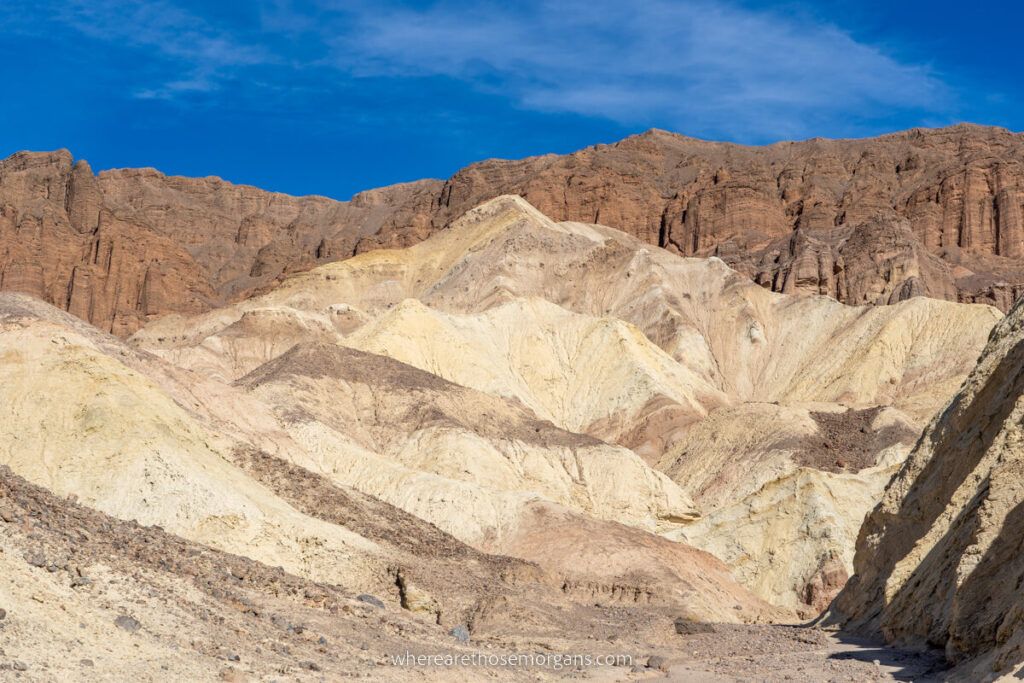
When standing at Zabriskie Point, look down at the Badlands and slightly to the right. You will be able to see Manly Beacon and further the Red Cathedral.
As we mentioned earlier, you can hike from Zabriskie Point to Red Cathedral. However, you can park on Badwater Road and hike a shorter trail through the Golden Canyon to reach Red Cathedral instead.
Golden Canyon is a 3 mile out and back labyrinth of narrow tunnels and golden mounds requiring some ledge climbing and overhang ducking.
If you’re a big hiker, you can skip the out and back, instead hiking a loop by circling round to Gower Gulch. This makes the hike longer but far more picturesque.
Golden Canyon Trail is one of the best hikes in the US and we strongly recommend you make time for it.
Time Required: Depends how far you go – 1 hour 30 minutes to Red Cathedral and back or 2 hours 30 minutes for the loop.
6. Harmony Borax Works
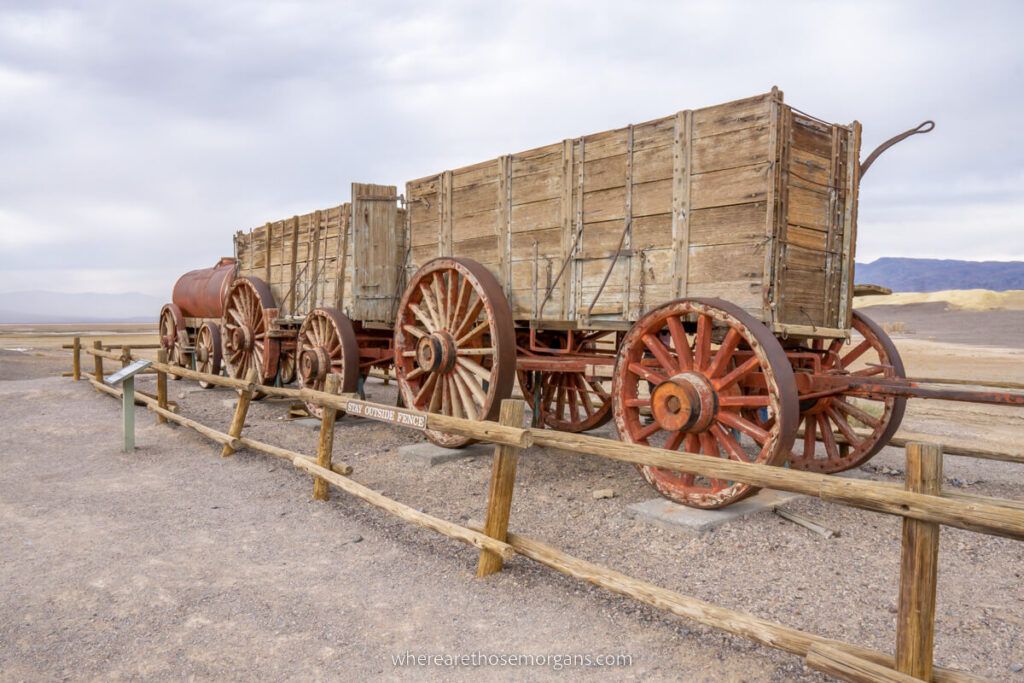
Borax is a natural mineral used in many household cleaners, laundry detergents and even teeth bleaching products today. This mineral played an important role of putting Death Valley on the map back in 1881.
Between 1883-1889, three million tons of borax were produced daily by the Harmony plant, but getting the product to the nearest railway line in the Mojave Desert required improvisation.
A 20 mule team pulling double wagons hauled the Borax through Death Valley, which has since become a symbol of the Borax industry.
There are many informative and educational boards to read here to learn about Death Valley’s oldest industry. This is a really easy and quick stop on your Las Vegas to Death Valley day trip.
Time required: 20-30 minutes.
7. Mesquite Flat Sand Dunes
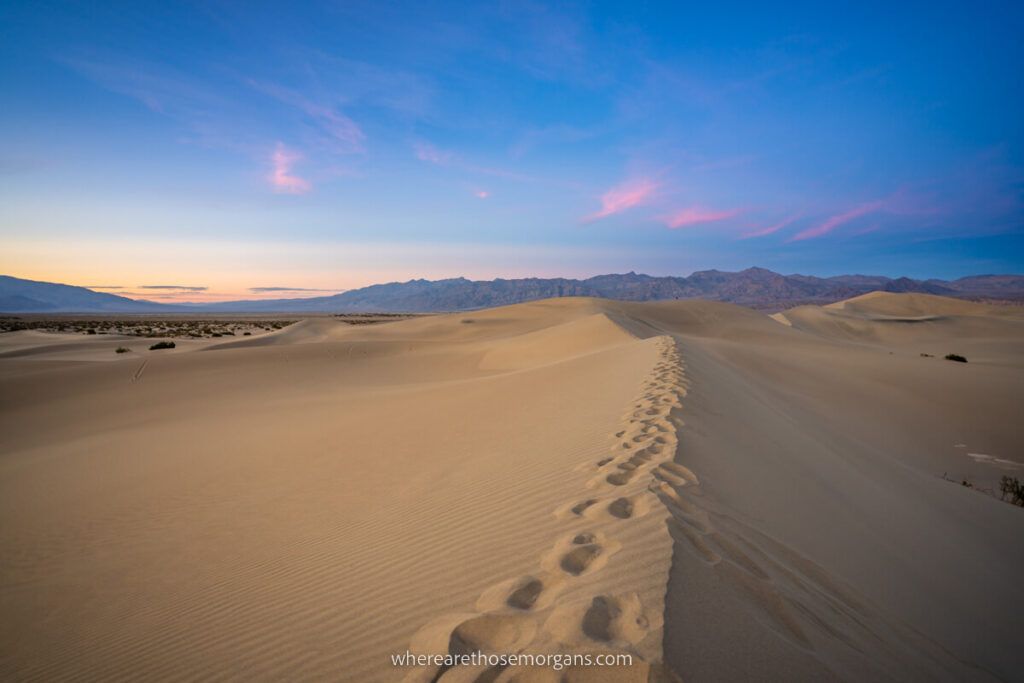
When you think of a desert, what is the first thing that comes to mind?
Sand, right?
Well, less than one percent of Death Valley is covered in sand dunes. But because Death Valley covers 3.4 million acres that one percent makes for a handful of amazing sand dune areas.
You won’t be able to reach Eureka Dunes in the far north of Death Valley on a day trip. But you can stop at Mesquite Flat Sand Dunes near Stovepipe Wells.
Mesquite Flat Sand Dunes is a very popular stop in the park. It is busiest around sunset with couples seeking a romantic spot on the sand, instagrammers and pro photographers.
You will find linear, crescent and star shaped dunes with the traditional curved ripples you imagine from sand dunes.
Sandboarding is possible on these dunes but they only rise to a maximum of 100 feet at their peaks.
Time required: 2 hours (more for photographers and sandboarders).
8. Mosaic Canyon Trail
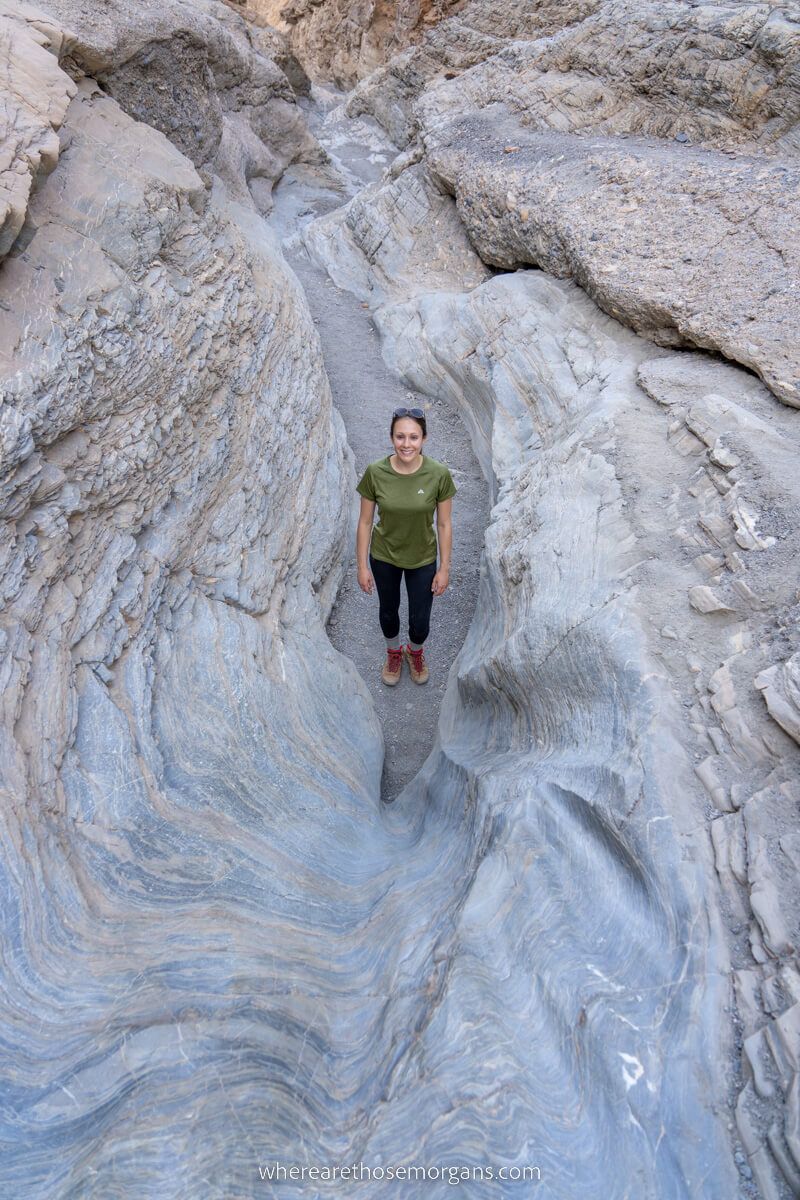
Mosaic Canyon Trail is an adventurous hike into a stunning Death Valley canyon.
Hikers will have to navigate boulders and find feint paths running up sheer faces, before walking across ledges and up dry beds.
There are several times when it appears you can’t go any further, but you can and you have to figure out how!
Look out for smooth marble rock formations and attractive fragments of Mosaic Canyon Braccia, the colorful rocks from which the trail is named after.
The best part of this hike is that very few people know about Mosaic Canyon. It is much quieter than Golden Canyon and the other popular tourist spots in the park.
Time required: 2 hours to the end and back
9. Rhyolite Ghost Town
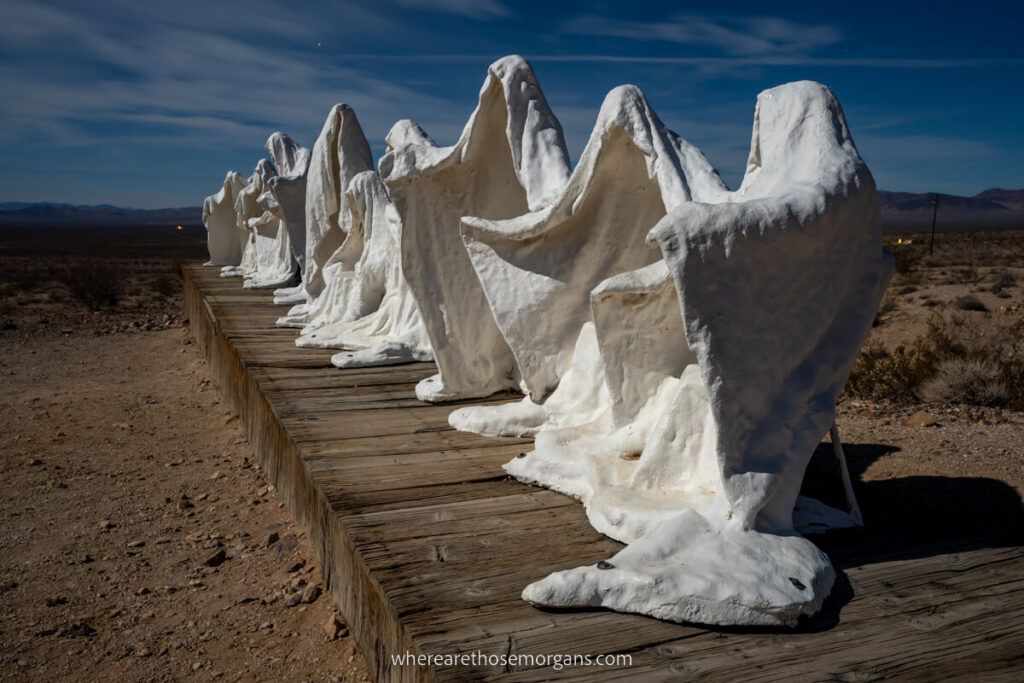
Rhyolite is a fantastic example of a ghost town. The town sprang up hastily in 1905 as one of many mining camps during the Death Valley gold rush boom.
In a very short space of time Rhyolite was kitted out with infrastructure like electricity, water mains, hospital, school and even an opera house.
All of these services were financed by steel magnate Charles M Schwab.
Once the most profitable ore had been exhausted, Rhyolite declined faster than it was formed. In a few short years the entire town had been abandoned, leaving buildings close to the Las Vegas bound train station in the dust.
Technically Rhyolite is just outside the Eastern boundary of Death Valley and is in fact in Nevada. But it is near the beginning of Titus Canyon’s one way entrance close to the town of Beatty.
Today you can see the remains of the Cook building bank’s front facade, the railroad depot and an old gas station among other smaller buildings.
Pro-tip – If you stay at Death Valley for a night and enjoy photography, Rhyolite makes for the perfect place to paint abandoned trucks and building with light at night.
Time required: 30 minutes to 1 hour on site.
10. Titus Canyon
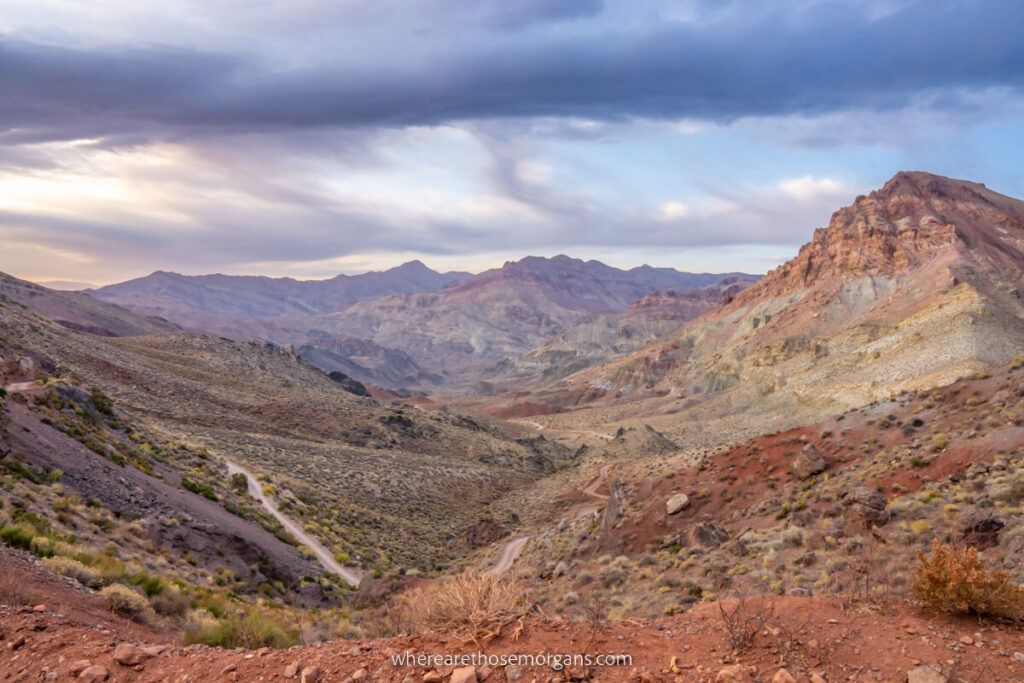
Titus Canyon is an incredible 27 miles long 4WD drive through some of the most magical terrain in Death Valley.
The road is steep, narrow and extremely rough at times. You will find yourself driving under 5mph for a lot of this trail.
In truth, we probably shouldn’t have driven Titus Canyon in a Ford Escape during our first visit to Death Valley. But we made it, and it was one of the most fun things we’ve done in any US national park to date.
Titus Canyon is an awesome one way drive over and through rugged and beautifully colored mountains. You will pass through another ghost town, petroglyphs, rare plants and spot wildlife such as Bighorn Sheep.
Important – We very highly recommend you use caution before proceeding into Titus Canyon.
The route is one way, so you can’t turn around once you begin. You will certainly need to carry spare tires, puncture repair tools, plenty of food and water plus warm clothing if visiting outside of Summer.
This road is rarely patrolled and we only saw one other vehicle the entire time we were driving through the canyon.
The Titus Canyon grand finale?
A phenomenal 1.5 mile section of extremely narrow (less than 20 feet across) constantly curving canyons with tall walls to either side.
A bit like the Narrows hike at Zion National Park but you’re driving and there’s no water!
Time required: At least 2 hours but more likely to be 3 hours.
Las Vegas To Death Valley One Day Road Trip Routes
Here are the two routes we will cover:
- Enter via Death Valley Junction and leave via Beatty
- Enter via Beatty and leave via Death Valley Junction
Let’s get into the itinerary examples!
Itinerary 1 – Enter Via Death Valley Junction
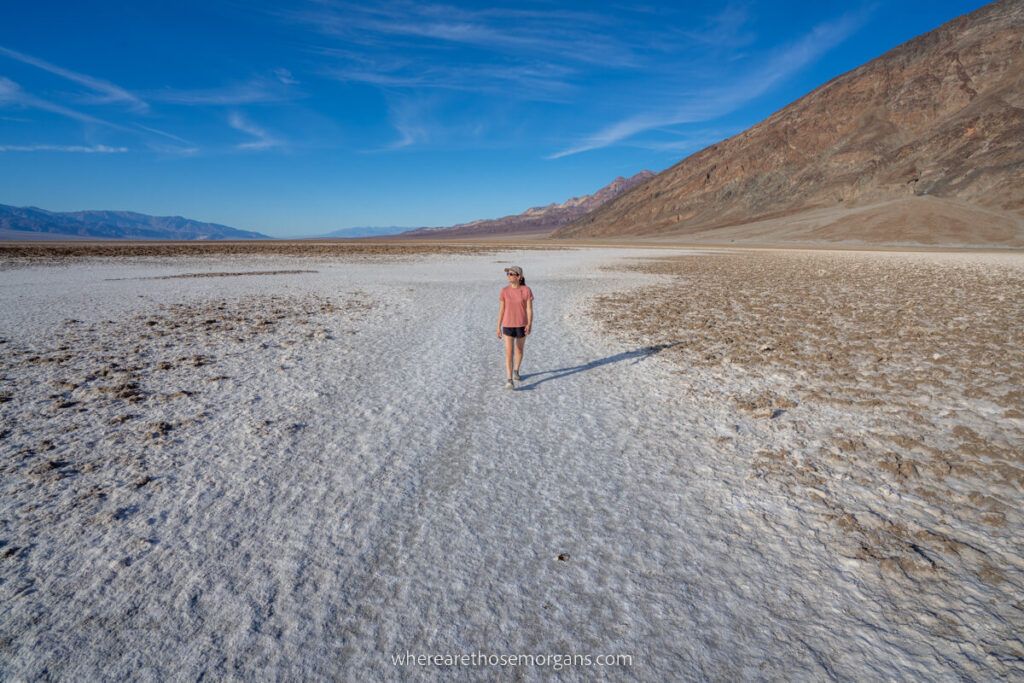
1. Zabriskie Point
Check sunrise times for Death Valley the night before you leave Las Vegas.
We highly recommend trying to make Zabriskie Point for sunrise if possible, which means a really early start from Vegas.
Not to worry if sunrise is simply too early for you to make. You can still check out the most popular overlook in Death Valley once you arrive.
Enjoy views as the early morning sun illuminates the remarkable landscape below and ahead.
Alternative
If you’re not interested by the touristy and busy Zabriskie Point, you can skip it and go instead to Dante’s View, which is the best viewpoint in Death Valley.
However, it would mean a lot more driving, plus the road up to Dante’s View is narrow, steep and winding.
2. Badwater Basin
Leave Zabriskie Point and drive towards Furnace Creek but take the first left onto Badwater Road, just after you pass the luxurious Death Valley Inn.
Suppress any urges to stop, you want to drive all the way to Badwater Basin while it’s still early before the mid morning masses arrive.
Head out into Badwater Basin, walk as far and wide as you need to blow the cobwebs off from the drive over.
Don’t forget to get a photograph with the lowest point in North America sign. If you time it right for hexagonal crystals, you’ll need a bit more time for photography.
3. Natural Bridge
Turn back on yourself and take the first right to Natural Bridge parking lot.
Walk up into the cool canyon, slightly uphill and loose stones underfoot make it more difficult than it should be. It’s worth the effort to see the bridge and barren waterfalls.
4. Devil’s Golf Course
Continue back towards Furnace Creek.
You can take the next left to Devil’s golf course (not a real golf course!) if you have time. Devil’s golf course is a massive expanse of flat land with sharp salt rocks as far as you can see.
It is more ‘otherworldly’ than Badwater Basin but not as iconic or photogenic.
5. Artist’s Palette
A little further up take the right into Artists Palette one way scenic drive.
This one is definitely worth it. Stop at the parking lot and take a quick walk among the surreal colorful mounds.
The drive is fun and you may even be tempted to drive it again just for the roads!
6. Golden Canyon
Last stop before reaching Furnace Creek is Golden Canyon and it is not one to miss.
Walk all the way to Red Cathedral and decide if you want to return or take on the loop. Remember, this hike passes through unique and interesting terrain.
7. Furnace Creek
Drive to Furnace Creek village, check out the visitor center for information and ranger programs.
Otherwise, there’s not a huge amount to do at Furnace Creek except grab some snacks and take on a few gallons of water. If you need to fill up with gas, now is the time.
8. Harmony Borax Works
Walk the short loop trail among the old ’20 mule team’ historical area, learn about the Borax works of the 1880’s and enjoy the views.
9. Salt Creek Interpretive Trail
Take the half mile wooden boardwalks in a loop alongside a spring.
This wouldn’t be worth your time if it were anywhere else, but the views of Death Valley make it a worthwhile stop.
10. Mesquite Flat Sand Dunes
Follow the 190 north towards Stovepipe Wells. Take in the scenery around you as you drive through the heart of Death Valley.
Take the left into Stovepipe Wells, stop for any necessary food, water and gas.
Park up at the Mesquite Flat Sand Dunes parking lot and get lost in the sand for an hour! It will be baking hot in the middle of the day so use caution.
Sandboard, photograph or simply enjoy the hot dry sand between your toes.
11. Mosaic Canyon
Hike the adventurous Mosaic Canyon Trail until it reaches a dead end.
This is a really fun hike and we would recommend any experienced hikers prioritize this trail over other stops such as Harmony Borax and Salt Creek.
Alternative
Hike Mosaic Canyon before you venture out into Mesquite Flat if you want to be out on the sand dunes for sunset.
12. Titus Canyon
If you have a high clearance vehicle (we hope you do!), it’s time for the best part of your day trip from Las Vegas to Death Valley.
Drive up Daylight Pass road until you reach Titus Canyon Trailhead. Turn left and head into the mountains for a memorable few hours.
Important – If you plan to drive Titus Canyon, you should aim to begin no later than 3 hours before sunset.
13. Rhyolite
If you don’t have a 4WD vehicle or you don’t want to go driving through the mountains for a few hours, head straight to Rhyolite after Mosaic Canyon instead.
Be sure to get out and explore this creepy area by foot. Take plenty of photos of the abandoned structures, vehicles and ghosts.
It will be getting late by now and this is your last stop on the way out of Death Valley via Beatty and back to Las Vegas.
If it is dark, don’t forget your camera and tripod to take long exposures of Rhyolite under a sky full of stars.
Itinerary 2 – Enter Via Beatty
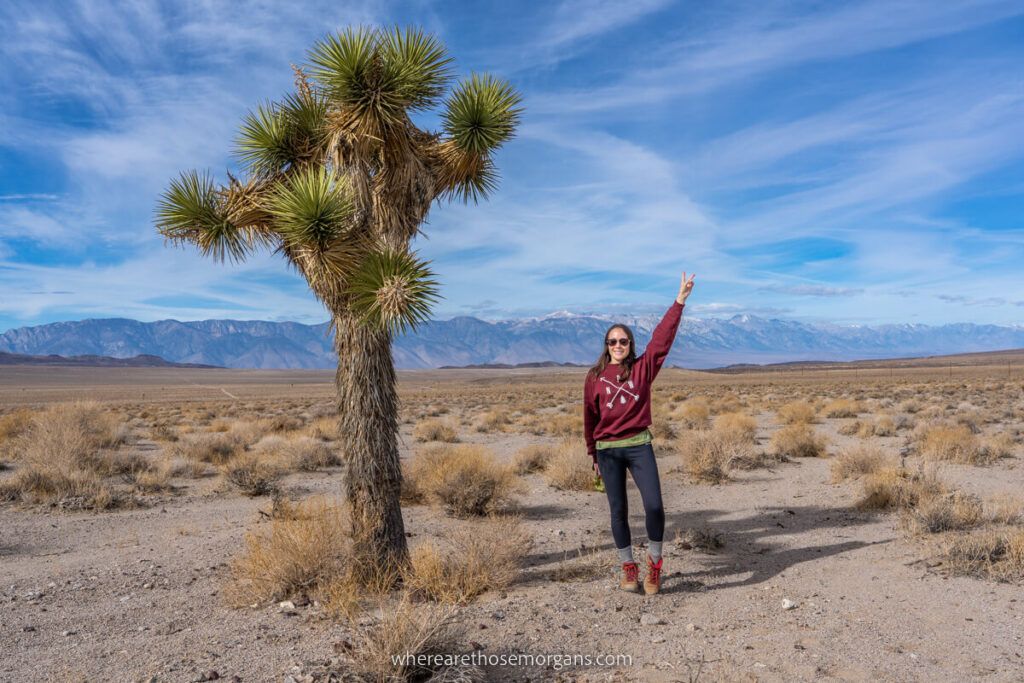
1. Rhyolite
Flipping the road trip loop on its head, you will start in Rhyolite ghost town in the early morning hours.
This place probably feels even more eerie at dawn than it does in the dark at night.
2. Titus Canyon
Driving Titus Canyon works more efficiently in this itinerary version as you are driving in the right direction and won’t have to come back on yourself afterwards as you would in the other version.
Again, only try this road if you have a 4WD vehicle. It’s a lot of fun and you won’t regret it!
3. Mesquite Sand Dunes
Head down to Stovepipe Wells and stock up with any goods you need.
Park up and hit the soft sand dunes. The good news is you will be here much earlier in the day so the sand should be cooler and the sun won’t be so strong.
4. Mosaic Canyon
Hike Mosaic Canyon in the early morning and you might even have the trail to yourself.
You could switch the dunes with this hike if you would prefer to hike in cooler conditions, before taking it easier on the dunes.
5. Salt Creek
Stop here on the way down to Furnace Creek if you have the kids in town, otherwise it might be one to skip.
6. Harmony Borax Works
Another one for the kids or for those who don’t plan to spend much time hiking trails.
You can easily fill in your one day Death Valley itinerary with plenty of smaller stops like this one at Harmony Borax.
7. Furnace Creek
Restock on supplies, grab more water, fill up with gas and check out the visitor center exhibits.
If you’re running short on time and you don’t need any resupplies, skip past Furnace Creek to recoup some valuable minutes.
8. Badwater Basin
Drive all the way down to Badwater Basin as it is the furthest point you will go on this road.
Walk out into the brilliant white salty basin and get a shot of the lowest point in North America sign.
You could even try some perspective photographs like you see from Bolivia’s salt flats. Take some tiny figurines or props for fun images.
9. Natural Bridge
Turn around and take the first right to Natural Bridge.
Hike up the loose stones into the tunnel-like canyon and don’t forget to check out both the dry waterfalls.
10. Devil’s Golf Course
Take the next left to Devil’s golf course if you’re doing well for time.
Gaze upon the huge field of sharp jagged rocks and imagine the guy who gave the area its name originally back in the 1930’s saying ‘only the Devil could play golf on such a surface’.
11. Artists Palette
Don’t miss artist’s palette drive and walk, particularly if you prefer photography to hiking. The colorful mounds are intriguing, especially the stunning deep turquoise.
We would suggest skipping Natural Bridge before Artists Palette if the afternoon hours are dwindling.
12. Golden Canyon
Remember, Golden Canyon is the most iconic and quintessential Death Valley hike, so make sure you have enough time to hike either the out and back or the loop version.
Skip all of the lesser stops mentioned above if you want to hike the full Golden Canyon loop.
13. Zabriskie Point
On the way out of Death Valley back towards Las Vegas, you have the choice of Zabriskie Point or Dante’s View for your final vista.
Dante’s View is the superior view but is also a lot more driving and effort. Decide based on time and how much energy you have left.
Remember you still have a 2 hour drive from Death Valley to Las Vegas and chances are high you will be exhausted by now. If that’s the case, stick with Zabriskie Point.
What To Do With More Time In Death Valley
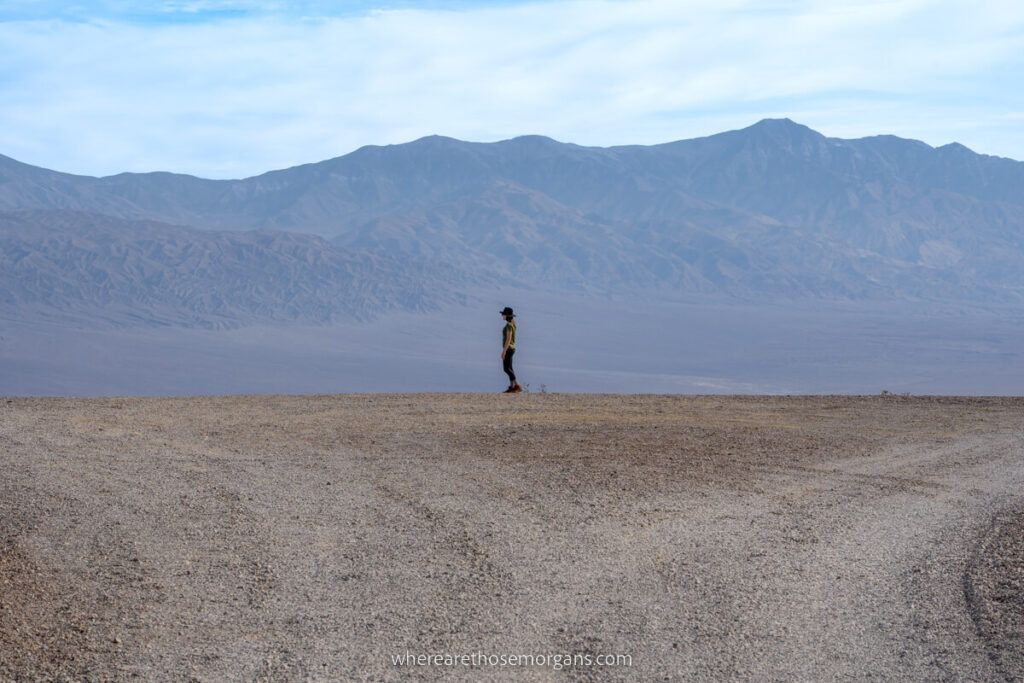
Right back at the beginning of this guide we mentioned there were a few things you wouldn’t be able to see on a day trip from Las Vegas to Death Valley.
In truth, you could quite easily pick one or two of the further out attractions, but that would mean missing the bulk of the tourist classics in Death Valley.
Here are explanations for each of the remaining most popular things to do in Death Valley for you to consider on your next visit.
1. The Racetrack
One of the most intriguing things to see among all US National Parks is The Racetrack in Death Valley. It is essentially a flat dried up lake surface with small individual rocks moving slowly and leaving trail marks.
How do rocks move on a flat surface?
Good question! Scientists say that rain and wind allow stones to move extremely slowly on flat surfaces, but some of these rocks in Death Valley have traveled over 1,500 feet.
Is it a hoax?
Who knows, but either way you will need a 4 wheel drive high clearance vehicle to reach The Racetrack and it’s quite a way off the main road.
2. Ubuhebe Crater
Ubuhebe Crater is a huge volcanic crater half a mile wide and 600 feet deep, created by steam and gas explosions in the Northwest of Death Valley.
If you’re more interested in geology than hiking, be sure to consider driving up to the impressive looking crater.
3. Scotty’s Castle
Walter Scott was a con artist who effectively stole money from wealthy investors from Eastern US who believed he had discovered a gold mine in Death Valley.
Scott spent all of the money living the high life before all investors but one pulled out when he produced not a single ounce of ore.
The one investor remaining – Albert M Johnson – became enamored with Death Valley and the two men became lifelong friends.
Scott built a huge house for Johnson, known as Scotty’s castle and today it is a museum.
Important – Scotty’s Castle has been closed for some time now. We will update when it reopens.
4. Telescope Peak
Telescope Peak is the best adventure trail in Death Valley but it only recommend for serious hikers and backpackers.
The 14 mile roundtrip hike gains 3,000 feet in elevation and is usually covered in snow, even in June. Hiking this trail is one of the only things best suited to Summer in Death Valley.
5. Dante’s View
As mentioned in the itineraries above, Dante’s View is the best viewpoint in Death Valley. However, it isn’t easy to access, especially on a Las Vegas to Death Valley day trip.
If you have more time, definitely consider drive up to the viewpoint (long vehicles not permitted).
If you visit Death Valley on a particularly clear day with no dust or haze, it might be worth considering including Dante’s View and excluding some of the shorter hikes or other attractions on the above itineraries.
Death Valley Tours From Las Vegas
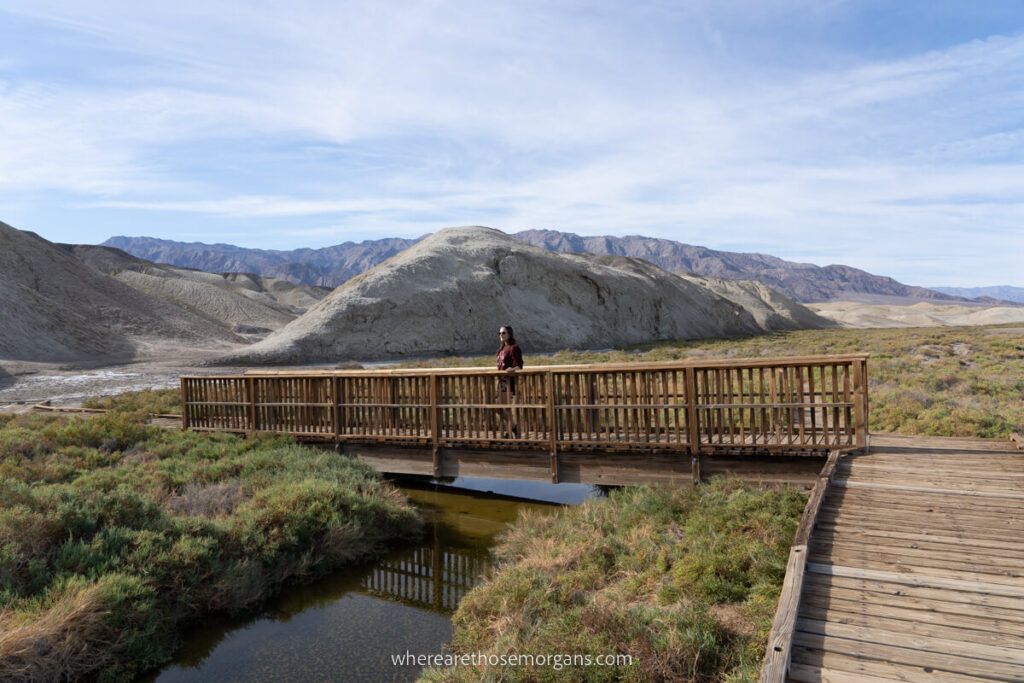
Don’t have a car during your visit to Vegas but you still want to see the hottest place on Earth?
Not to worry, there are plenty of tour options available taking hundreds of tourists from Las Vegas to Death Valley each day.
We’ve taken a look through all of the best tours and picked out three with high ratings from previous visitors spanning the budget range.
Here are the top rated tours available:
Viator
1. Full Day – This full day 10-12 hour coach tour of Death Valley from Las Vegas is top rated and easily affordable. You will see the top highlights of the park, with hotel pickup and drop off, plus brunch and all entry fees included.
2. Small Group – This 10 hour small group guided tour travels from Las Vegas by SUV or mini-bus and covers double the amount of sights in Death Valley. It is more expensive but you will have a more immersive experience.
Get Your Guide
1. Full Day – This 10 hour tour is highly rated and the cheapest option for seeing Death Valley from Las Vegas. You will see the top highlights of the park, with hotel pickup and drop off, plus lunch and all entry fees included.
Where To Stay In Death Valley
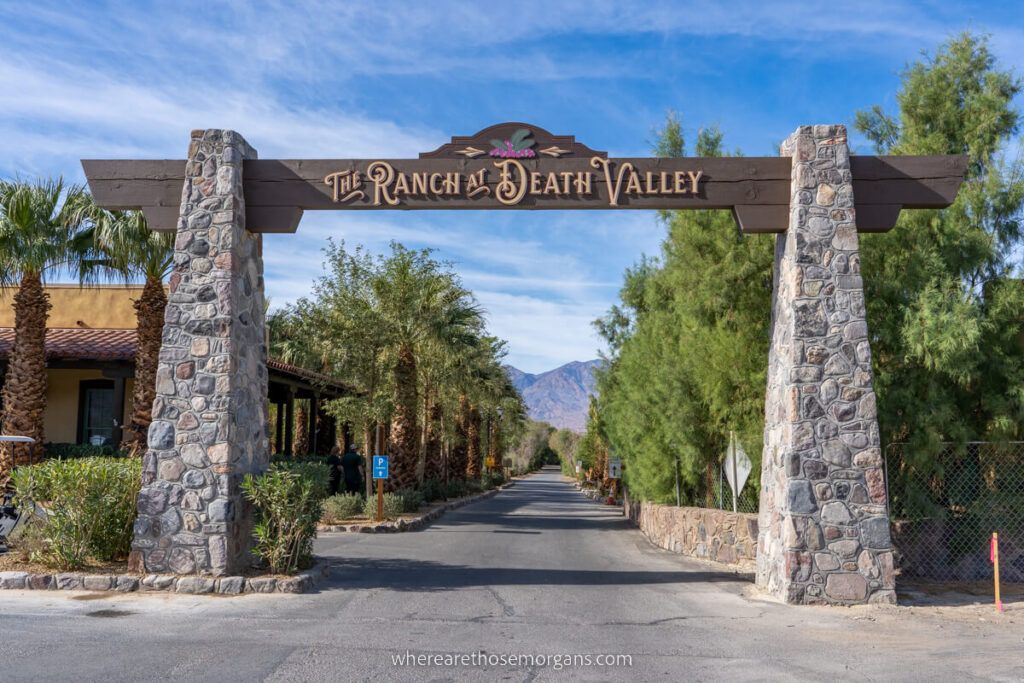
If you decide to turn your day trip into a one or two night stay in Death Valley, you are going to need a place to sleep and that is easier said than done in this national park.
Start by reading our comprehensive guide to the 13 best hotels at Death Valley to see all of your hotel options inside and outside the national park.
Hotels Inside Death Valley
If you don’t mind splashing out, you can stay in relative luxury right in the heart of Death Valley. Furnace Creek offers both a ranch and an inn.
Ranch At Death Valley
The ranch is slightly cheaper, featuring outdoor pool, tennis court and access to the golf course – yes, there’s a real golf course in Death Valley!
>> Check availability and prices for the Ranch at Death Valley.
Inn At Death Valley
The more expensive inn looks stunning, featuring outdoor pool, fitness center, sauna and lovely rooms.
>> Check availability and prices for the Inn at Death Valley.
Stovepipe Wells
Stovepipe Wells offers a hotel and restaurant at more affordable rates when compared to Furnace Creek. The hotel is located near Mesquite Flat Sand Dunes.
>> Check availability and prices for Stovepipe Wells.
Panamint Springs
Alternatively, you can stay in Panamint Springs at a lower quality motel which is still quite expensive but is located right on the West boundary – ideal for driving to Yosemite National Park early the next morning.
>> Check availability and prices for Panamint Springs Motel.
Hotels Outside Death Valley
Outside of the park boundaries you have several tiny towns offering cheaper hotel rooms and better amenities. But it means you will have to drive out and back into Death Valley on your second morning.
Here are some of the places you will find limited lodging near Death Valley:
- Lone Pine to the West of Death Valley is close to Mount Whitney and the Alabama Hills. It is also on the way to Yosemite and offers a number of accommodations. See our guide to the 5 best hotels in Lone Pine CA for more information.
- Beatty (close to Rhyolite) has a small number of affordable motels near east entrance to Death Valley.
Our popular guide on how to book cheap hotels will show you a few new tricks to try when looking for your next hotel.
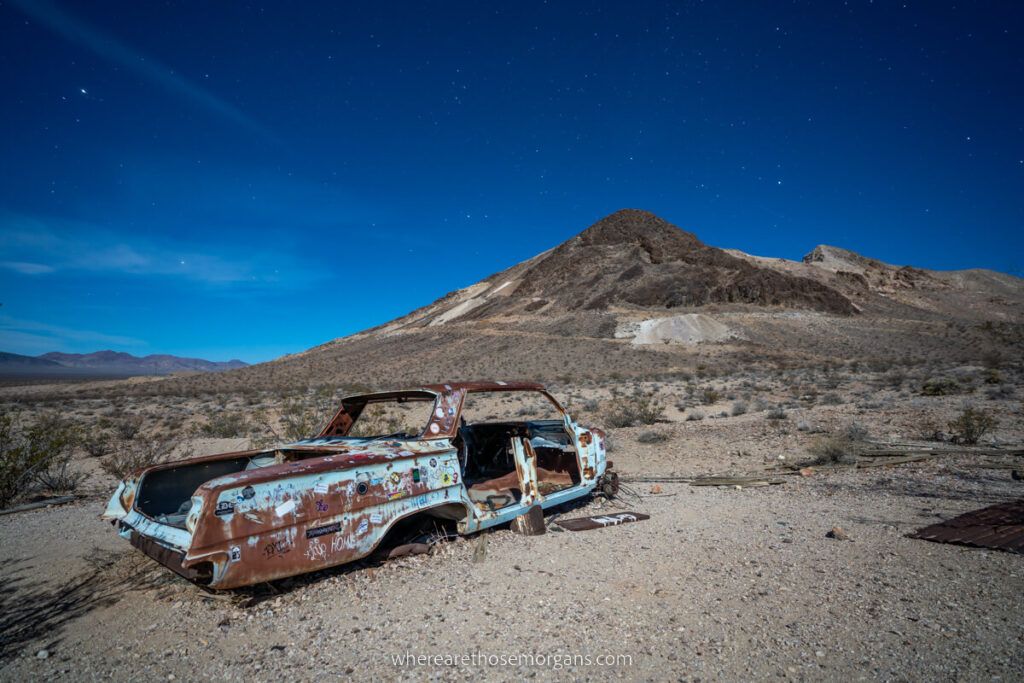
Death Valley Campgrounds
For the purpose of this itinerary, we will provide details for only the 4 major campgrounds in case you decide to stay a night or two.
There are 5 smaller campgrounds dotted around Death Valley at higher altitude and more isolated regions.
- Of the main campgrounds, only Furnace Creek is open during Summer months due to high temperatures.
- All 5 of the smaller campgrounds are at high altitude, therefore cooler in Summer and open all year.
- The 4 major campgrounds plus Mesquite cost between US$ 14-28 per night, the remaining 4 smaller campgrounds are free.
All campgrounds require payment via automated machine on site at the campground.
Furnace Creek Campground – Open all year, reservations required October 15 to April 15 but not required in Summer, 136 sites and all services provided.
Sunset Campground – Open Fall to Spring, no reservations, 270 sites and some services. We stayed here and it’s more like a car parking lot than a campground! You will not be able to peg your tent into the ground.
Texas Spring Campground – Open Fall to Spring, no reservations, 92 sites and all services provided.
Stovepipe Wells Campground – Open Fall to Spring, no reservations, 190 sites and some services provided.
Las Vegas To Death Valley Day Trip FAQ’s
Let’s take a look at the most frequently asked questions regarding a Las Vegas to Death Valley day trip.
Yes, it is definitely worth driving from Las Vegas to Death Valley National Park. Death Valley is a quick, easy and attraction filled day to include on your Las Vegas itinerary.
Three days is the perfect amount of time to spend in Death Valley if you want to see and do everything the park has to offer. However, you can easily see the top Death Valley highlights in one day.
The shortest routes to enter Death Valley from Las Vegas are by entering via either Death Valley Junction to the southeast or Beatty to the east. These two routes form a perfect loop back to Las Vegas.
It is 118 miles and 2 hours 10 minutes drive from Bellagio hotel half way up the Las Vegas strip to Furnace Creek in Death Valley National Park.
More From Around Death Valley
Winter– Planning to visit Death Valley in Winter? Here are the 10 most important things you need to know about visiting Death Valley in December.
Las Vegas – Planning to spend a few days in Vegas? Here are the 40 best things to do in Las Vegas both on and off the famous strip.
Las Vegas Day Trips – Planning other day trips on your visit to Vegas? Here are the 10 most popular Las Vegas day trips with details on how to DIY or take a tour.
Valley Of Fire – The complete list of 15 best things to do on a visit to Valley of Fire, including family friendly hikes and beautiful photo spots.
Red Rock Canyon – Looking for another awesome place to hike near Las Vegas? Here’s our guide to the 10 best hikes at Red Rock Canyon less than half an hour from the Vegas strip.
Hot Springs – Driving northwest from Death Valley? Don’t miss the 20 best Northern California hot springs, natural hot pools with mountain views.
Yosemite National Park – Heading to Yosemite after Death Valley? Here’s our popular Yosemite National Park itinerary for one, two and three day visits.
Our Popular US Southwest Guides
Grand Canyon – A must visit landscape, here is our ultimate guide to visiting Grand Canyon South Rim and our popular hiking guide the 17 best hikes at Grand Canyon South Rim.
Sedona – One of our favorite places to visit in the US, here are our guides to the 20 best things to do in Sedona, the 20 best hikes in Sedona and the perfect Sedona itinerary.
Zion – One of the most popular US national parks, here are our guides to the 20 best hikes in Zion and the perfect one day Zion itinerary.
Want more California content? Head over to our California Travel Guides to explore National Parks, popular road trips and things to do in major cities of the sunshine state.
We hope this Las Vegas to Death Valley day trip guide help with planning your visit to the American Southwest!
Please let us know if you have any questions or need help planning your trip.
Happy Travels,
Mark and Kristen
Find This Guide Helpful? Pin It For Your Visit To Death Valley!
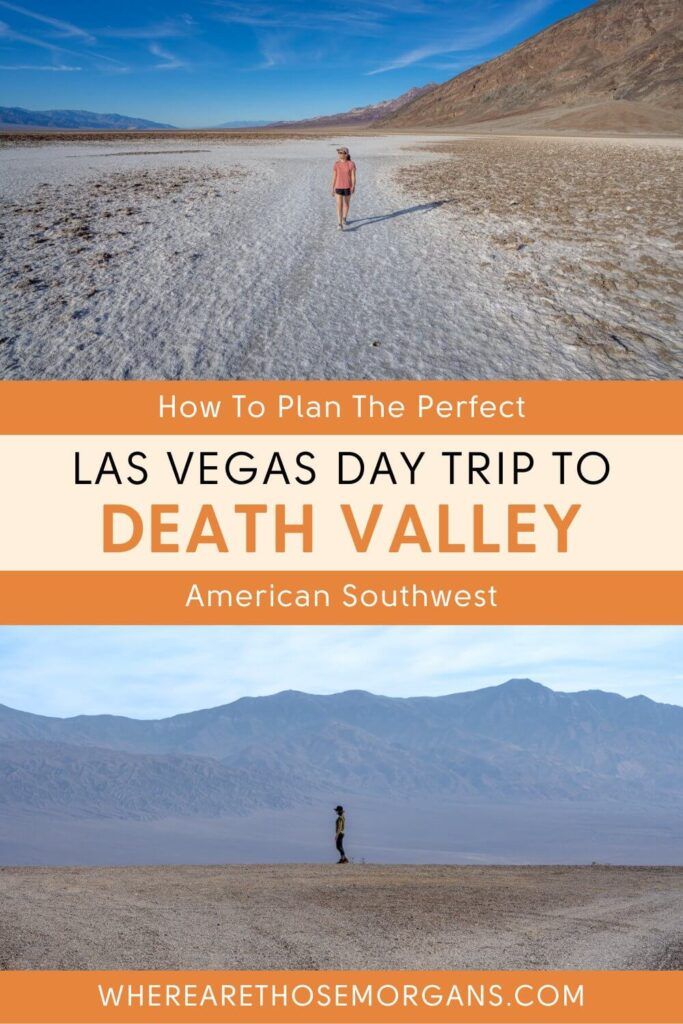
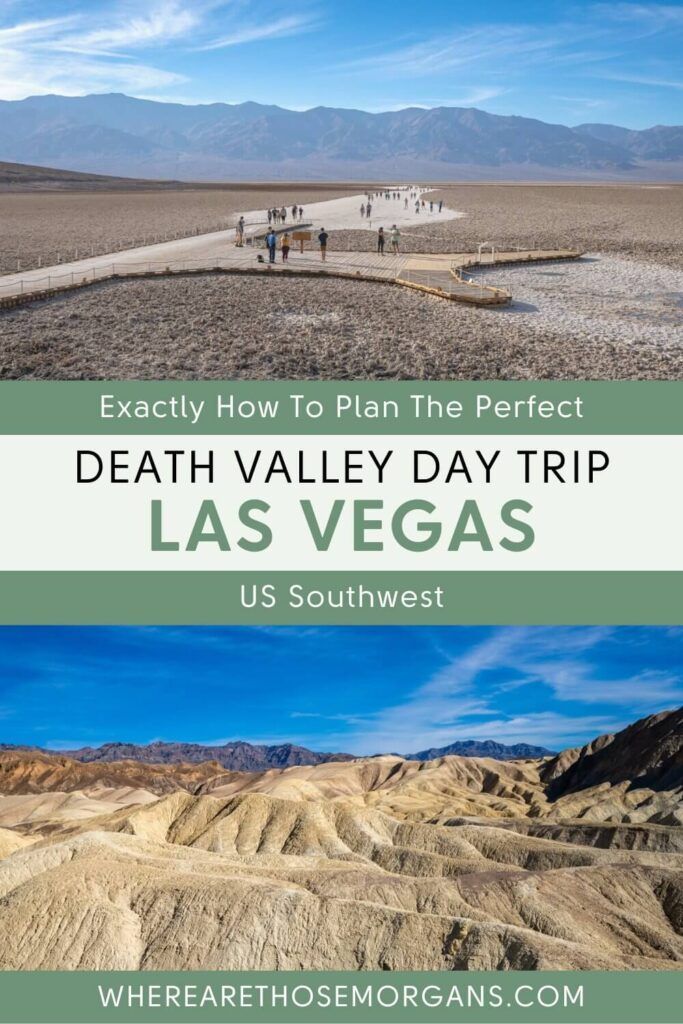
Note: This article contains affiliate links. When you make a purchase using one of these affiliate links, we may earn a small commission at no extra cost to you.
All Rights Reserved © Where Are Those Morgans, LLC. Republishing this article and/or any of its contents (text, photography, maps, graphics, etc.) in whole or in part is strictly prohibited.
Mark and Kristen Morgan are travel, hiking and photography experts. Over the last 6 years traveling full time, they have explored more than 40 countries and 30 US states.
Where Are Those Morgans has been featured in USA Today, Gestalten, Get Your Guide, CityPASS and Condé Nast Traveler along with various other publications. Read more about us.

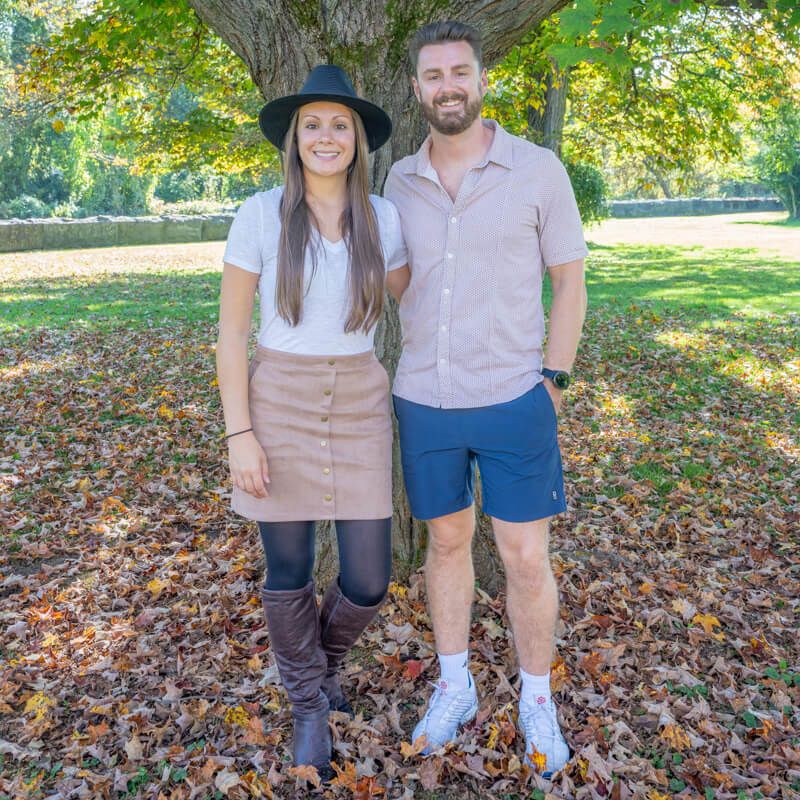
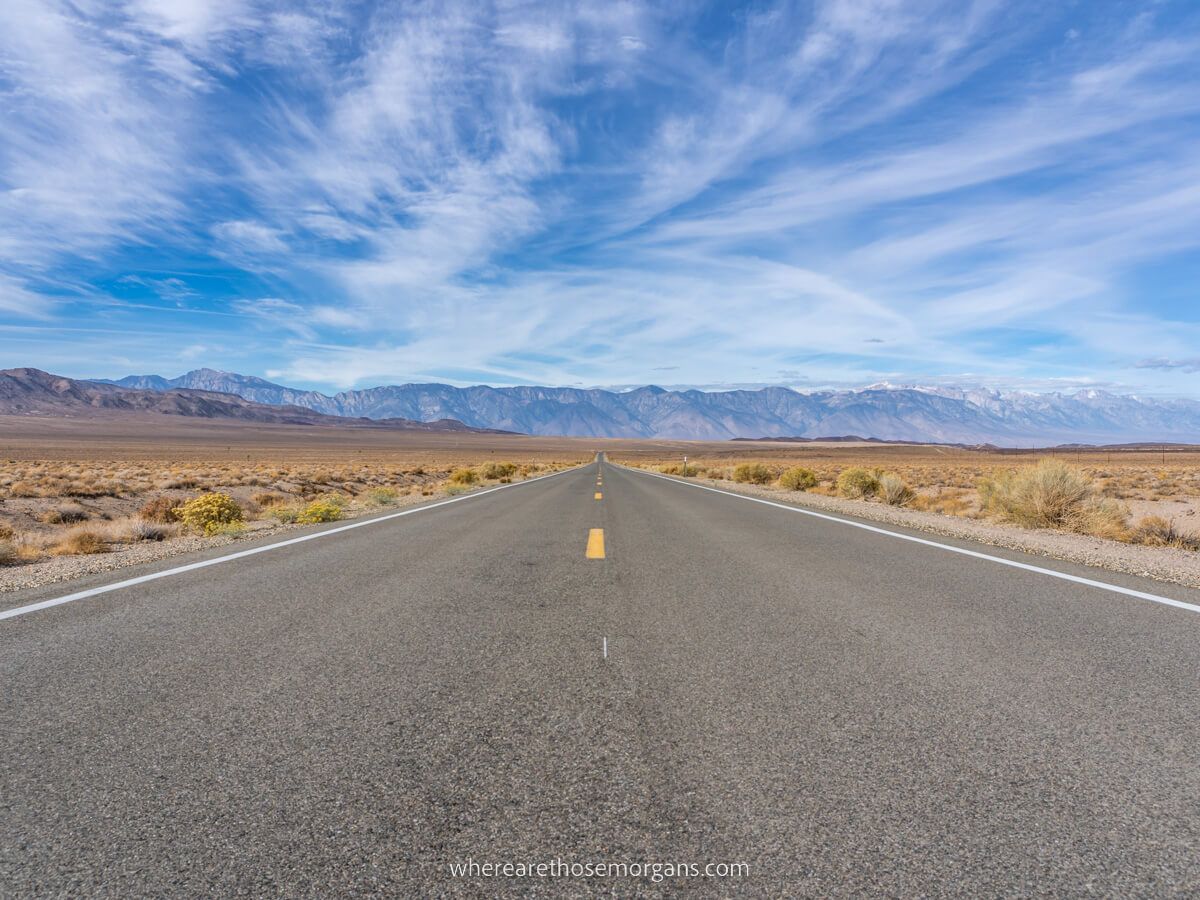
Thanks for great information. This article has helped me map my death valley trip from Vegas. 1 question do we get to see the death valley national park sign when Entering Via Death Valley Junction
Hi Hema, yes you will drive right past the Death Valley National Park sign around half way between Death Valley Junction and Furnace Creek on 190. Here is the exact location of the sign to open in Google Maps. Have a fantastic trip!
Wow Death valley looks like an amazing place, great information and photos. Unbelievable heat but I think I would put up with it for that scenery.
Thank you Graham, it’s easy to write about awesome landscapes such as Death Valley. It was hot and hostile when we visited in October, got caught in a massive dust storm but that added to the Death Valley experience!